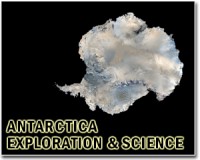| . |  |
. |
Cambridge, UK (SPX) Jun 23, 2010 New results from an investigation into Antarctica's potential contribution to sea level rise are reported this week (Sunday 20 June) by scientists from the British Antarctic Survey (BAS), Lamont-Doherty Earth Observatory (LDEO) and the National Oceanography Centre in the journal Nature Geoscience. Thinning ice in West Antarctica is currently contributing nearly 10 per cent of global sea level rise and scientists have identified Pine Island Glacier (PIG) as a major source. As part of a series of investigations to better understand the impact of melting ice on sea level an exciting new discovery has been made. Using Autosub (an autonomous underwater vehicle) to dive deep and travel far beneath the pine Island Glacier's floating ice shelf, scientists captured ocean and sea-floor measurements, which revealed a 300m high ridge (mountain) on the sea floor. Pine Island Glacier was once grounded on (sitting on top of) this underwater ridge, which slowed its flow into the sea. However, in recent decades it has thinned and disconnected from the ridge, allowing the glacier to move ice more rapidly from the land into the sea. This also permitted deep warm ocean water to flow over the ridge and into a widening cavity that now extends to an area of 1000 km" under the ice shelf. The warm water, trapped under the ice, is causing the bottom of the ice shelf to melt, resulting in continuous thinning and acceleration of the glacier. Lead author Dr Adrian Jenkins of British Antarctic Survey said, "The discovery of the ridge has raised new questions about whether the current loss of ice from Pine Island Glacier is caused by recent climate change or is a continuation of a longer-term process that began when the glacier disconnected from the ridge. "We do not know what kick-started the initial retreat from the ridge, but we do know that it started some time prior to 1970. Since detailed observations of Pine Island Glacier only began in the 1990s, we now need to use other techniques such as ice core analysis and computer modelling to look much further into the glacier's history in order to understand if what we see now is part of a long term trend of ice sheet contraction. This work is vital for evaluating the risk of potential wide-spread collapse of West Antarctic glaciers." Co-author Stan Jacobs adds: "Since our first measurements in the Amundsen Sea, estimates of Antarctica's recent contributions to sea level rise have changed from near-zero to significant and increasing. Now finding that the PIG's grounding line has recently retreated more than 30 km from a shallow ridge into deeper water, where it is pursued by a warming ocean, only adds to our concern that this region is indeed the 'weak underbelly' of the West Antarctic Ice Sheet. Increased melting of continental ice also appears to be the primary cause of persistent ocean freshening and other impacts, both locally and downstream in the Ross Sea."
Share This Article With Planet Earth
Related Links British Antarctic Survey Beyond the Ice Age
 Antarctic ice melt: 10 percent of sea rise
Antarctic ice melt: 10 percent of sea riseCambridge, England (UPI) Jun 22, 2010 New research led by the British Antarctic Survey shows West Antarctica's ice melt currently contributes nearly 10 percent of the global sea level rise. An international team of researchers - including scientists from the Lamont-Doherty Earth Observatory at Columbia University in New York and the Britain's National Oceanography Center - identified the antarctic's Pine Island Glacier as ... read more |
|
| The content herein, unless otherwise known to be public domain, are Copyright 1995-2010 - SpaceDaily. AFP and UPI Wire Stories are copyright Agence France-Presse and United Press International. ESA Portal Reports are copyright European Space Agency. All NASA sourced material is public domain. Additional copyrights may apply in whole or part to other bona fide parties. Advertising does not imply endorsement,agreement or approval of any opinions, statements or information provided by SpaceDaily on any Web page published or hosted by SpaceDaily. Privacy Statement |